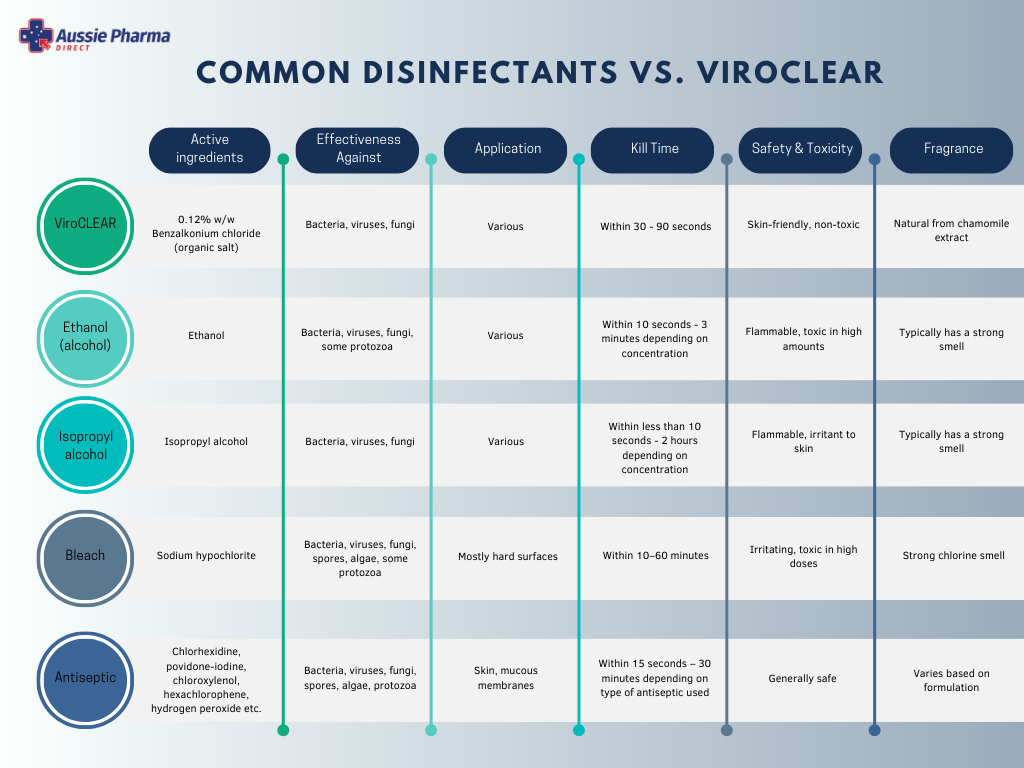
What’s Your Choice of Disinfectant? ViroCLEAR and Other Disinfectants Compared
, by Angelina Zoldos, 8 min reading time

, by Angelina Zoldos, 8 min reading time
In an era where hygiene is paramount, especially when diseases run rampant, the market is flooded with a myriad of disinfectants, each claiming to be the best. With the many types of disinfectants out there, from sprays to wipes, traditional disinfectants offer convenience but often come with concerns about chemicals and environmental impact that give way for more natural alternatives.
Though you can easily concoct your own natural disinfectant from ingredients you can find in your pantry, there are certain brands that are formulated to use the power of nature while ensuring effective germ elimination. One of those brands is ViroCLEAR, and we’re going to compare what makes it a better alternative to other common disinfectants.
Disinfectants come in various forms, each tailored to specific needs and settings. Here's a breakdown of some common types:
Natural disinfectants harness the power of plant-based ingredients and eco-friendly components to combat harmful microorganisms without the use of harsh chemicals. Unlike traditional disinfectants, natural alternatives offer several distinctive features:
Now, a lot of us may have this idea that antiseptic can be used to disinfect surfaces but there is actually a difference between antiseptic and disinfectant, and it lies in their intended use and effectiveness.
Antiseptics are designed for use on living tissues and are gentle enough not to cause significant harm to the skin or mucous membranes. They are employed to prevent infection in wounds, cuts, and other injuries. Antiseptics are crucial in healthcare settings and personal hygiene routines to maintain skin integrity and prevent the spread of infections.
Disinfectants, on the other hand, are intended for use on inanimate objects and surfaces. They are more potent than antiseptics and are specifically formulated to destroy or eliminate harmful microorganisms found on surfaces. Disinfectants play a vital role in maintaining cleanliness in environments such as homes, hospitals, and public spaces.
But what if we tell you that there is a product that works as both an antiseptic and disinfectant? Let us introduce you to ViroCLEAR.
ViroCLEAR relies on cutting-edge BioInnovate technology to create a non-alcohol formulation that contains lower levels of active ingredients required to pass tests for a 'Kills COVID-19 claim.' ViroCLEAR stands out from the crowd due to its key ingredient: Benzalkonium chloride.
1. Benzalkonium chloride
Remember when we said that there is a difference between antiseptic and disinfectant? Well, that is applied to the common traditional antiseptic and disinfectant products that serve its purpose separately.
Benzalkonium chloride in ViroCLEAR is a quaternary ammonium compound that serves as both a powerful disinfectant and antiseptic agent. This organic salt, with its proven antimicrobial properties against bacteria, viruses, and fungi, makes ViroCLEAR a powerful contender in the disinfection game.
Chemical structure:
Benzalkonium chloride is a cationic surfactant, meaning it has both hydrophilic (water-attracting) and lipophilic (fat-attracting) properties. This unique structure allows it to disrupt the lipid layers of bacterial and viral cell membranes, leading to their destruction. By compromising the integrity of these membranes, Benzalkonium chloride renders microorganisms unable to function, ultimately causing their demise.
Antimicrobial properties:
Benzalkonium chloride exhibits potent antimicrobial properties against bacteria, viruses, and fungi. It is effective against both Gram-positive and Gram-negative bacteria, making it versatile in combating various bacterial strains. Additionally, it has been proven effective against enveloped viruses, including many types of influenza and coronaviruses. Its ability to inhibit fungal growth further solidifies its role as a broad-spectrum antimicrobial agent.
While Benzalkonium chloride is generally safe for use in regulated concentrations, especially that found in ViroCLEAR (which is 0.12% in low concentration), it is essential to always follow product guidelines and recommendations.
2. Chamomile extract
Aside from Benzalkonium chloride, ViroCLEAR contains 1-2% of chamomile extract, renowned for its various beneficial properties, including anti-inflammatory, antioxidant, and calming effects, especially for those with sensitive skin. While chamomile extract does contain compounds that have mild antimicrobial properties, it is not primarily used as a disinfectant.

By selecting the right disinfectant, you ensure targeted elimination of the germs relevant to your environment, whether it's a healthcare facility, a household, or a public space. Some disinfectants contain chemicals that can be harmful if misused or overused. For instance, strong chemical disinfectants like bleach can cause skin and respiratory irritation.
Choosing a disinfectant with a balanced formulation ensures effective disinfection while prioritising the safety of individuals who come into contact with treated surfaces. So, it often boils down to effectiveness, safety, and versatility.
Next, it’s time to declutter, reorganise, clean, and disinfect!
As spring approaches in Australia, many people embrace the age-old tradition of spring cleaning. Beyond tidying up, it's also an ideal time to disinfect living areas thoroughly, and this means disinfecting commonly-touched surfaces to create a healthier environment, which is why your choice of disinfectants is important. If you’re one that is all for natural alternatives, ViroCLEAR disinfectant is an option to be best considered in your spring clean checklist.